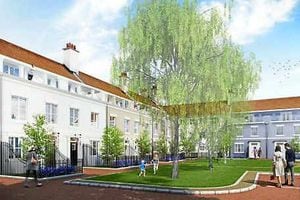Mystery of nuclear bunker under Ludlow offices set to become housing
A nuclear bunker remains under the streets of former council offices in Ludlow which are set to be replaced by housing, it has been revealed.

Councillors are hoping to document the bunker which sits beneath the former Stone House offices in Ludlow, which were once the home of Shropshire Council and Ludlow Town Council.
The site has been sold to housing developer Purcell, with plans for the offices to be demolished and 25 homes to be built and artists' impressions have been released.
But the fate of the bunker remains uncertain, and mystery still surrounds its origins and use.
Andy Boddington, Shropshire councillor for Ludlow North and a former archaeologist, said it must have been built along with the Stone House offices in 1989, well after the peak years of nuclear paranoia during the Cold War.
Plans show half of the bunker is taken up with store rooms, but no obvious living quarters.
Councillor Boddington said: "It has a toilet and shower, and also a plant room, presumably for a diesel or electric generator.
"The rest of the space is taken up with corridors and stairs. This seems to be little more than a storage bunker with loo and shower attached. So what did this bunker contain? Iodine tablets? Emergency rations? Official papers?"
He added: "I've asked for a site visit early in February with Shropshire Council's heritage team and the developers. I want to ensure that it is fully recorded before the site is developed. Any memories or local knowledge will be very welcome."
Fellow councillor Vivienne Parry said she believed the bunker was originally designed to house a set number of named people and the plans showing mostly storage were probably drafted at a later date. She remembers hearing about the bunker going back to the days of South Shropshire District Council, pre-2009.
She said: "I did know there was a bunker under there but I was never allowed to see it. I was told they don't really want people knowing about it.
"I found out about it because my sister lived next to one of the big houses owned by the council in Preston and they had one there – so I asked if we had something similar, and we did.
"In Preston we went to see it on an open day and they said only 13 or 14 people would be allowed in, with their names on the beds, and they wouldn't be allowed to bring any family.
"It was quite shocking to hear that but it was something that was decided when they thought someone could drop an atomic bomb on us."
